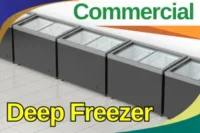Different Types of Inverter Air Conditioners Explained Simply
Published: 19 Oct 2025
It’s a hot afternoon, and your old air conditioner is running full blast, but the room still feels warm. The electricity bill keeps climbing, and you start wondering if there’s a smarter way to stay cool. That’s when many people discover inverter air conditioners – they promise comfort with less power use. But here’s the thing: not all inverter ACs are the same. Each type has its own way of cooling and saving energy. Understanding the types of inverter air conditioners can help you choose one that truly fits your home and lifestyle. In this simple guide, we’ll explain every type in clear, easy language so you can make the right choice.
So are you ready? Let’s discuss in detail.
Types of Inverter Air Conditioners
Inverter air conditioners come in many types. Each type works on the same inverter technology but is made for different needs. Some are best for small rooms, while others are built for big spaces like offices or malls. Knowing the types helps you choose the right one for your home or workplace.
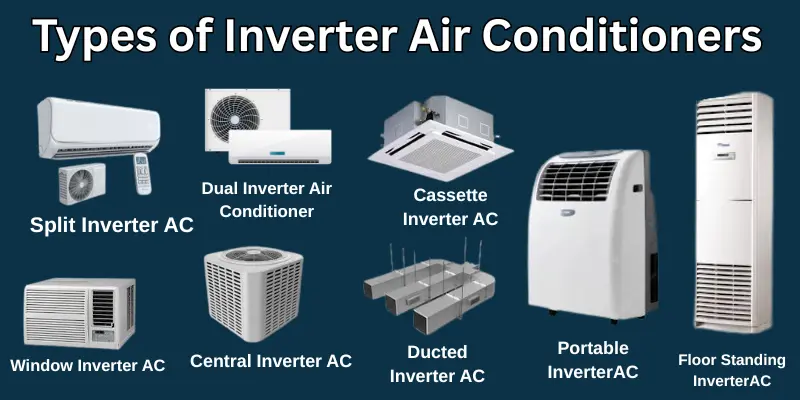
This list covers every main type of inverter air conditioner you will find today. It includes common home models, smart types, and even large commercial systems.
Here are all the main types:
- Split Inverter Air Conditioner
- Window Inverter Air Conditioner
- Portable Inverter Air Conditioner
- Dual Inverter Air Conditioner
- Triple Inverter Air Conditioner
- Smart Inverter Air Conditioner
- Multi-Zone Inverter Air Conditioner
- Cassette Inverter Air Conditioner
- Floor Standing Inverter Air Conditioner
- Ceiling Suspended Inverter Air Conditioner
- Ducted Inverter Air Conditioner
- Hybrid Inverter Air Conditioner
- VRF / VRV Inverter Air Conditioner
- Commercial Central Inverter Air Conditioner
Now we will talk about all these types one by one in simple words.
1. Split Inverter Air Conditioner
A split inverter air conditioner has two units – one inside the room and one outside. The indoor unit blows cool air, while the outdoor unit releases the heat. It uses inverter technology to save power and keeps the room temperature steady without turning on and off again and again.
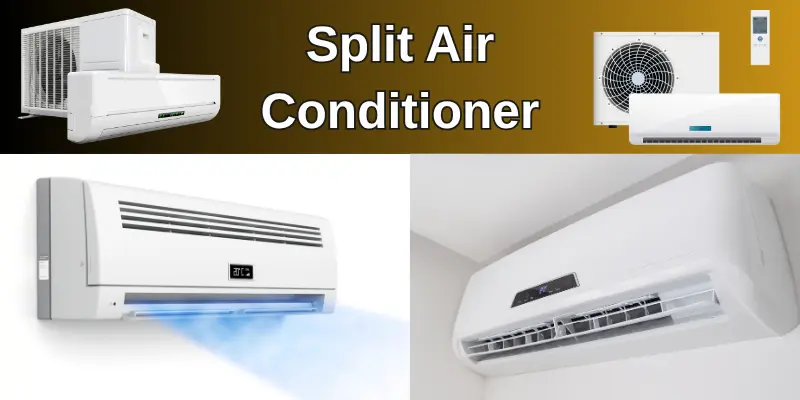
Main Features:
- Works quietly, perfect for bedrooms or living rooms.
- Gives strong and even cooling across the room.
- Saves more electricity than normal split ACs.
- Has a clean and modern look that fits any home.
- Easy to control with a remote or mobile app (in smart models).
Real-life Examples:
- A family uses it in their living room for silent cooling.
- Office cabins where people work long hours and need steady comfort.
- Small shops that want a clean look without window units.
Who Should Choose It:
If you want powerful cooling with less noise and lower electricity bills, this is the best choice. I always suggest a split inverter AC for homes and small offices.
Quick Comparison:
Unlike a window inverter AC, the split inverter AC is quieter and cools larger spaces better.
2. Window Inverter Air Conditioner
A window inverter air conditioner is a single compact unit that fits in a window or a small wall space. It works using inverter technology, which means it cools the room faster and saves more energy than old-style window ACs. It is simple, easy to install, and perfect for small areas.
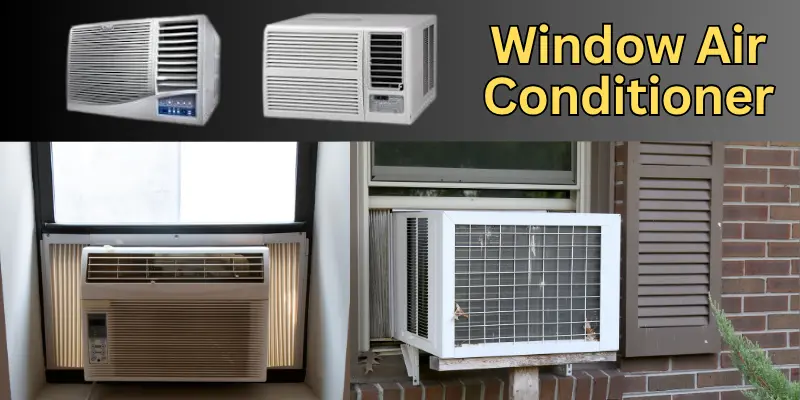
Main Features:
- All parts are in one box, making it easy to set up and maintain.
- Uses inverter technology to reduce electricity use.
- Cools small rooms quickly and keeps the temperature steady.
- Usually more affordable than split inverter ACs.
- It can be removed and shifted easily if you move homes.
Real-life Examples:
- A student using it in a hostel or rented flat.
- A family installs it in a guest room for quick comfort.
- Small offices use it for single-room cooling.
Who Should Choose It:
If you live in a small apartment or need a budget-friendly option, this is a smart pick. I always suggest window inverter ACs for people who want easy setup and good cooling at a lower price.
Quick Comparison:
Compared to a split inverter AC, the window model costs less and is simpler to install, though it makes a little more noise.
3. Portable Inverter Air Conditioner
A portable inverter air conditioner is a small, movable unit that you can roll from one room to another. It runs on inverter technology, which means it cools the room efficiently while using less power. It doesn’t need any permanent installation, making it a flexible and easy option for many homes.
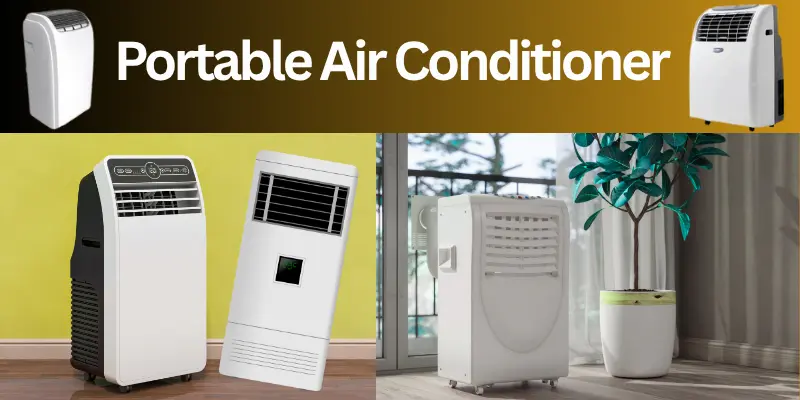
Main Features:
- It can be moved anywhere with wheels for easy mobility.
- Needs no wall mounting or outdoor unit.
- Uses inverter technology for steady cooling and power saving.
- Ideal for places where drilling or permanent setup is not allowed.
- Compact size fits well in small spaces.
Real-life Examples:
- A renter who moves often and needs a cooling solution without installation.
- A family uses it in the living room during the day and the bedroom at night.
- People living in temporary setups or hostels.
Who Should Choose It:
If you want cooling without fixed installation, this is the right pick. I often suggest portable inverter ACs for renters and small families who like flexibility and easy movement.
Quick Comparison:
Compared to a window inverter AC, the portable type gives more freedom to move around but may cool a bit slower in larger rooms.
4. Dual Inverter Air Conditioner
A dual-inverter air conditioner uses two rotors in its compressor instead of one. This helps the AC cool faster, run more quietly, and save more electricity. It keeps the room temperature steady without frequent on-off cycles, giving smooth and comfortable cooling.
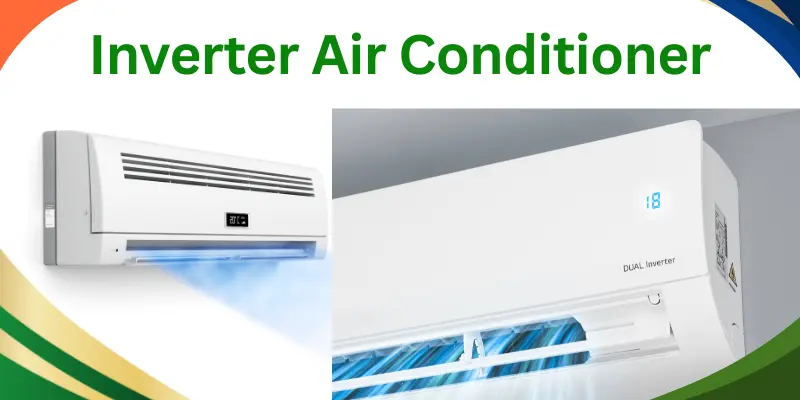
Main Features:
- Two rotors in the compressor for faster and smoother cooling.
- Saves more power than a regular inverter AC.
- Works quietly with very little vibration.
- Provides better temperature control and longer life.
- Ideal for both small and large rooms.
Real-life Examples:
- A family uses it in their living room for quick and even cooling.
- Offices that need steady comfort during long working hours.
- Homeowners who want high performance with low power use.
Who Should Choose It:
If you want faster cooling, less noise, and lower bills, a dual inverter AC is a great choice. I always recommend it to people who use their AC for long hours daily.
Quick Comparison:
Compared to a single inverter AC, the dual inverter model cools faster, saves more energy, and works more quietly.
5. Triple Inverter Air Conditioner
A triple inverter air conditioner is an advanced version of the dual inverter AC. It has a more refined compressor system that controls speed even better, giving extra smooth performance and more energy savings. This type focuses on quiet operation, faster cooling, and better control of room temperature.
Main Features:
- Uses a three-step inverter control for extra power efficiency.
- Cools faster than both single and dual inverter models.
- Runs very quietly, even at high speed.
- Maintains steady temperature with no sudden changes.
- Designed to handle long hours of continuous use.
Real-life Examples:
- Homes in hot areas where the AC runs most of the day.
- Offices that need quiet and consistent cooling for employees.
- Families looking for long-term energy savings.
Who Should Choose It:
If you want the best energy savings and top performance, a triple inverter AC is an excellent pick. I suggest it for people who want advanced cooling with less power use.
Quick Comparison:
Compared to a dual inverter AC, the triple inverter model gives smoother cooling and even more energy efficiency, though it usually costs a bit more.
6. Smart Inverter Air Conditioner
A smart inverter air conditioner is a modern AC that connects to Wi-Fi and can be controlled through your smartphone or voice commands. It uses inverter technology for energy savings and smart features for easy control. You can turn it on, change the temperature, or set a timer even when you are not at home.
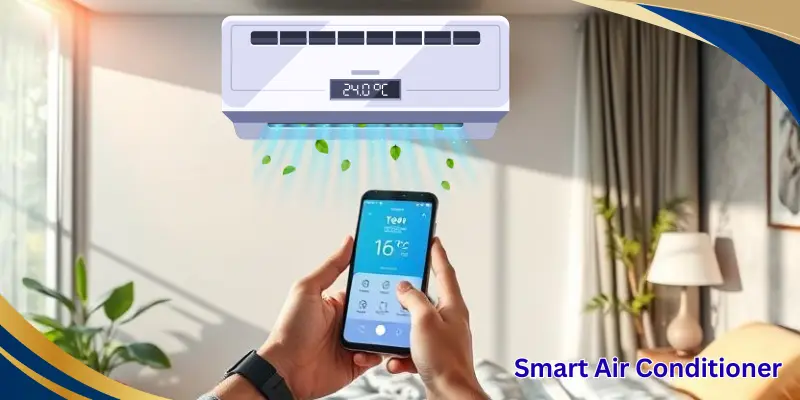
Main Features:
- Connects to Wi-Fi for mobile and voice control.
- Works with smart home devices like Alexa or Google Assistant.
- Uses inverter technology to save electricity.
- Lets you monitor energy use and room temperature.
- Can adjust cooling automatically for better comfort.
Real-life Examples:
- A homeowner controls the AC from the office before reaching home.
- Families setting timers at night for perfect sleep comfort.
- People use voice commands to change the temperature hands-free.
Who Should Choose It:
If you love smart gadgets and want convenience, this AC is perfect for you. I recommend it for modern homes where people enjoy using technology to make life easier.
Quick Comparison:
Compared to a dual-inverter AC, the smart inverter AC adds Wi-Fi control and automation, making it more convenient but slightly more expensive.
7. Multi-Zone Inverter Air Conditioner
A multi-zone inverter air conditioner uses one outdoor unit to cool several rooms at once. Each room has its own indoor unit, and you can set a different temperature for each one. It saves space outside and keeps the whole home or office comfortable without needing multiple outdoor systems.
Main Features:
- One outdoor unit supports several indoor units.
- Each room’s temperature can be controlled separately.
- Uses inverter technology for steady and energy-efficient cooling.
- Saves outdoor space and reduces noise.
- Ideal for large homes, villas, or multi-room offices.
Real-life Examples:
- A big family house where every bedroom needs a different cooling level.
- Offices where each cabin wants separate temperature settings.
- Hotels that prefer one outdoor setup for several rooms.
Who Should Choose It:
If you have a large home or need cooling in many rooms, this system is the best choice. I often suggest it for people who want comfort in every room without installing many outdoor units.
Quick Comparison:
Compared to a split inverter AC, the multi-zone type cools several rooms together, while the split AC can handle only one room at a time.
8. Cassette Inverter Air Conditioner
A cassette inverter air conditioner is fixed in the ceiling and blows cool air in four directions. It uses inverter technology to save energy while giving strong and even cooling. This type is often used in offices, shops, restaurants, and large rooms where wall space is limited.
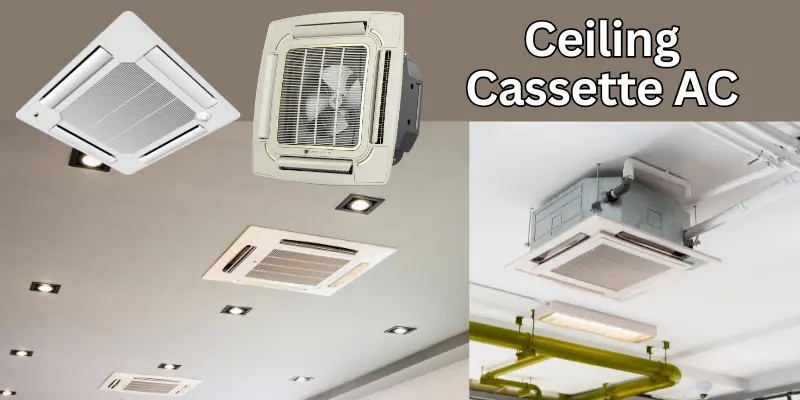
Main Features:
- Mounted in the ceiling for a neat and clean look.
- Spreads cool air evenly in all directions.
- Saves energy with inverter technology.
- Works quietly and blends well with modern interiors.
- Best for big rooms, offices, or open areas.
Real-life Examples:
- A restaurant using it for cool air without wall units showing.
- An office where employees enjoy quiet and even cooling.
- A large living room in a modern home with a false ceiling.
Who Should Choose It:
If you want stylish cooling that covers a wide area, this is the right choice. I recommend cassette inverter ACs for offices and big rooms where looks and comfort both matter.
Quick Comparison:
Compared to a split inverter AC, the cassette type cools larger spaces more evenly but needs a false ceiling for installation.
9. Floor Standing Inverter Air Conditioner
A floor-standing inverter air conditioner is a tall unit that stands on the floor and gives strong, steady cooling. It works using inverter technology to save power while keeping large spaces cool. It is also called a “tower inverter air conditioner” because of its slim, upright design.
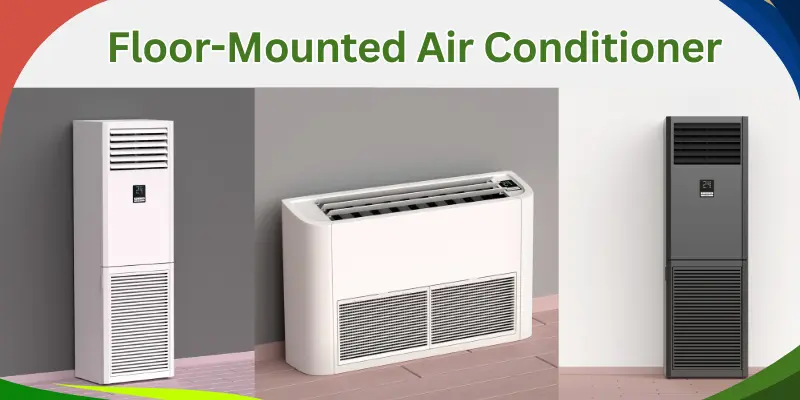
Main Features:
- Powerful cooling, perfect for large rooms or halls.
- Easy to install on the floor, no wall mounting needed.
- Uses inverter technology for energy efficiency and stable performance.
- Stylish design that looks neat in modern interiors.
- Strong air throw that reaches every corner of the room.
Real-life Examples:
- A restaurant is using it to cool the main dining area.
- A big living room where wall space is limited.
- An office hall that needs wide and steady cooling.
Who Should Choose It:
If you need fast and strong cooling for a large space, this type is the right choice. I recommend it for people who want both power and a modern look in one unit.
Quick Comparison:
Compared to a cassette inverter AC, the floor-standing model is easier to install and move, but takes up floor space instead of ceiling space.
10. Ceiling Suspended Inverter Air Conditioner
A ceiling suspended inverter air conditioner hangs from the ceiling and blows cool air across the room. It works with inverter technology to save power and provide steady, even cooling. This type is great for places where there is no false ceiling, but wall space is limited.
Main Features:
- Fixed directly to the ceiling without the need for a false ceiling.
- Spreads air widely across the room for even cooling.
- Uses inverter technology for quiet and energy-saving performance.
- Strong air throw makes it suitable for long or wide spaces.
- Easy to clean and maintain compared to ducted systems.
Real-life Examples:
- A classroom or meeting room that needs quiet and full-room cooling.
- A restaurant or shop with low wall space but an open ceiling.
- A hall where wall-mounted ACs can’t be installed.
Who Should Choose It:
If your room is large and doesn’t have space on the walls, this AC is a smart option. I recommend it for commercial places and halls where wall units are not practical.
Quick Comparison:
Compared to a cassette inverter AC, the ceiling suspended model does not need a false ceiling, making it easier to install in open areas.
11. Ducted Inverter Air Conditioner
A ducted inverter air conditioner is a hidden cooling system that sends air through ducts placed in the ceiling or walls. It uses inverter technology to cool large areas evenly while saving electricity. This type gives a clean, modern look because only the air vents are visible.
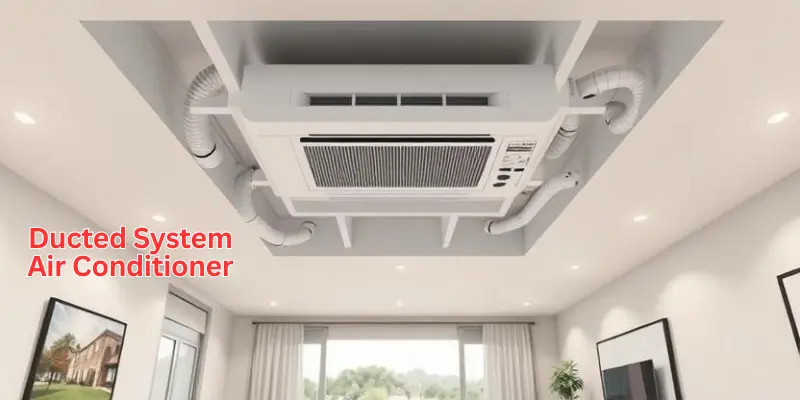
Main Features:
- A hidden indoor unit with air vents across different rooms.
- Cools big spaces evenly and quietly.
- Uses inverter technology for energy efficiency.
- Works well for both cooling and heating (in some models).
- Keeps interiors neat since no big unit is seen.
Real-life Examples:
- A modern villa with vents in each room for smooth airflow.
- An office building that needs quiet and centralized cooling.
- A showroom where design and clean interiors matter.
Who Should Choose It:
If you want a central cooling system that looks clean and runs quietly, a ducted inverter AC is a great choice. I recommend it for large homes, offices, or shops where design and comfort both matter.
Quick Comparison:
Compared to a cassette inverter AC, the ducted model is more powerful and hidden, but it needs more space for ducts and installation.
12. Hybrid Inverter Air Conditioner
A hybrid inverter air conditioner can run on both solar power and electricity. It uses inverter technology to save energy and adjusts cooling speed smartly. This type helps lower electricity bills and is good for people who care about energy savings and the environment.
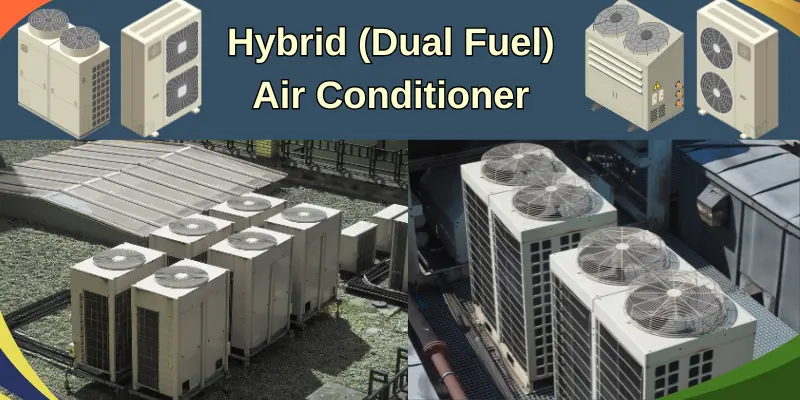
Main Features:
- Works with both solar panels and regular electricity.
- Saves more power by using inverter technology.
- Keeps cooling steadily even when the sunlight changes.
- It can switch automatically between solar and electric modes.
- Helps reduce electricity bills and carbon footprint.
Real-life Examples:
- A house with solar panels uses this AC to save daytime power.
- An office that wants lower energy costs with green solutions.
- A shop in a sunny area uses solar power during the day.
Who Should Choose It:
If you want an eco-friendly and cost-saving cooling option, this AC is perfect. I suggest it for homes and offices in sunny areas that want to use solar energy efficiently.
Quick Comparison:
Compared to a smart inverter AC, the hybrid type focuses more on saving power through solar energy than on remote or voice control features.
13. VRF / VRV Inverter Air Conditioner
A VRF (Variable Refrigerant Flow) or VRV (Variable Refrigerant Volume) inverter air conditioner is a powerful system made for large buildings. It uses inverter technology to control the flow of refrigerant to many indoor units from one outdoor unit. This system gives flexible, quiet, and energy-saving cooling for big areas.
Main Features:
- One outdoor unit supports many indoor units across different rooms or floors.
- Uses inverter control to adjust cooling for each room separately.
- Very energy-efficient for large buildings.
- Works quietly and maintains a stable temperature everywhere.
- It can provide both cooling and heating functions.
Real-life Examples:
- A hotel where each room has its own temperature control.
- A shopping mall with one outdoor unit serving many stores.
- An office building needing strong, centralized cooling.
Who Should Choose It:
If you manage a large space like an office, hotel, or commercial building, this system is ideal. I recommend it for places that need steady cooling and full control in every room.
Quick Comparison:
Compared to a multi-zone inverter AC, the VRF system is much stronger and built for bigger buildings with many rooms or floors.
14. Commercial Central Inverter Air Conditioner
A commercial central inverter air conditioner is a large cooling system made for big buildings like malls, hospitals, and offices. It uses inverter technology to control cooling power smartly and reduce energy use. This type cools wide spaces evenly through air ducts connected to a central unit.
Main Features:
- A central system that cools large areas through ducts.
- Uses inverter technology to save power and adjust cooling as needed.
- Works quietly even in heavy use.
- Can handle both cooling and heating in different zones.
- Designed for continuous operation in big spaces.
Real-life Examples:
- A shopping mall with one main system cooling all shops.
- A hospital uses central AC for smooth and even temperature control.
- A corporate office with one large AC system for all floors.
Who Should Choose It:
If you manage or own a large commercial space, this is the right choice. I recommend it for business owners who want reliable, energy-saving cooling for big buildings.
Quick Comparison:
Compared to a VRF inverter AC, the commercial central system is bigger and more powerful, but it needs more space and a higher installation cost.
Comparison of Types of Inverter AC
Before choosing an inverter air conditioner, it helps to see how each type differs. A quick comparison can make it easier to pick the right one for your room, office, or large space. Here’s a simple table to help you decide faster.
| Type | Best For | Main Features | Pros | Cons | Price (USD) |
| Split Inverter AC | Homes, offices | Indoor & outdoor unit, quiet cooling | Energy-saving, stylish | Costly installation | $400–$800 |
| Window Inverter AC | Small rooms | Single compact unit | Easy setup, budget-friendly | Noisy, blocks window | $300–$600 |
| Portable Inverter AC | Renters, small spaces | Movable, no fixed install | Easy to move, plug & play | Less powerful | $350–$700 |
| Dual Inverter AC | Medium homes | Twin rotors, faster cooling | High efficiency, quiet | Slightly costly | $500–$900 |
| Triple Inverter AC | Big homes | Three rotors, steady cooling | Very energy efficient | Expensive | $600–$1,000 |
| Smart Inverter AC | Tech lovers | Wi-Fi, app control | Remote use, voice control | Needs internet | $550–$950 |
| Multi-Zone Inverter AC | Multi-room buildings | One outdoor, many indoors | Flexible control | Complex setup | $1,000+ |
| Cassette Inverter AC | Shops, offices | Ceiling-mounted | Saves wall space | Needs a false ceiling | $800–$1,300 |
| Floor Standing Inverter AC | Large halls | Powerful vertical design | Strong airflow | Takes floor space | $700–$1,200 |
| Ceiling Suspended Inverter AC | Cafes, classrooms | Hangs from the ceiling | Covers a wide area | Professional install | $900–$1,500 |
| Ducted Inverter AC | Villas, offices | Hidden ducts, central cooling | Neat look, even cooling | High installation cost | $1,200+ |
| Hybrid Inverter AC | Eco-friendly users | Solar + grid power | Saves energy bills | Setup cost high | $1,000–$1,800 |
| VRF/VRV Inverter AC | Hotels, large offices | Variable refrigerant flow | Zoned cooling | Very costly | $2,000+ |
| Commercial Central Inverter AC | Malls, hospitals | Central duct system | Uniform cooling | Needs a large setup | $3,000+ |
How to Choose the Right Type of Inverter Air Conditioner
Choosing the right type of inverter air conditioner can make your home cooler, quieter, and more energy-efficient. Every type is made for a different kind of space — so picking the right one helps you stay comfortable and save money. Let’s look at how you can choose the best one for your home or office.
Check Your Room Size
Your room size is the first thing to think about:
- Small room (up to 150 sq. ft): Window or Portable Inverter ACs are perfect.
- Medium room (150–300 sq. ft): Split or Dual Inverter ACs offer better cooling and efficiency.
- Large rooms or homes: Go for Multi-Zone, Ducted, or Floor Standing types for stronger airflow.
- Offices or commercial use: VRF/VRV and Central Inverter ACs handle large spaces better.
Think About Power and Cost
According to recent energy studies, inverter air conditioners can save 30–40% more energy than non-inverter models.
If you use your AC for long hours daily, invest in a high-efficiency model like a Dual or Triple Inverter AC.
If you use it less often, a Window or Split Inverter AC can be enough.
Match the AC to Your Lifestyle
- Want Wi-Fi control or voice commands? Try a Smart Inverter AC.
- Move houses often? Choose a Portable Inverter AC.
- Have different rooms with different cooling needs? Pick a Multi-Zone Inverter AC.
Expert Recommendation
If I had to choose one model for most homes, I’d go with the Dual Inverter Split AC.
It’s quiet, cools fast, and uses less power.
For renters, I’d recommend a Window Inverter AC for its easy setup.
And for big homes or offices, go for Multi-Zone or Ducted Inverter ACs for even cooling across rooms.
Final Tip
Before you buy, check your room’s size, the AC’s tonnage, energy rating, and whether your brand offers service nearby.
Choosing wisely will give you the best comfort, save energy, and make your AC last longer.
Questions & Answers About Types of Inverter Air Conditioners
Buying an inverter air conditioner can raise a few extra questions. This section answers common doubts in simple, clear words so you can make the right choice.
Additional Questions You Might Have
- Can inverter air conditioners work effectively in very hot climates?
- How long does an inverter AC usually last compared to a normal AC?
- Do inverter ACs require more maintenance than regular ACs?
- Can I install an inverter AC myself, or do I need a professional?
- Is it better to buy a branded inverter AC or a local brand for the same type?
- How much electricity can I save with an inverter AC compared to a regular AC?
- Do different types of inverter ACs make different levels of noise?
- Can an inverter AC also provide heating in winter?
Now, let’s discuss the answers to all the questions one by one.
Yes, inverter air conditioners can work well even in very hot climates. They adjust the compressor speed to match the room’s temperature, so they can cool faster when it’s very hot. Many modern inverter ACs are designed to handle temperatures above 45°C. They also save electricity because they don’t keep turning on and off like normal ACs. If you live in a hot area, choose a high-efficiency inverter AC with a good energy rating for the best performance.
An inverter AC usually lasts longer than a normal AC. Because it runs continuously at different speeds instead of turning on and off, the compressor and other parts face less stress. On average, a good inverter AC can last 10–15 years with proper care. Regular maintenance, like cleaning filters and checking refrigerant, helps it stay efficient for many years. So, even though it may cost a bit more upfront, it often gives better value over time.
No, inverter ACs do not need more maintenance than regular ACs. You still need to clean the filters, check the refrigerant, and service the unit once or twice a year. In fact, because inverter ACs run more smoothly, their parts often last longer and face less wear and tear. Keeping it clean and having occasional professional check-ups will keep it working efficiently for many years. Regular maintenance also helps save electricity and improve cooling performance.
It’s best to have a professional install an inverter AC. These units need proper placement, correct electrical connections, and careful handling of the refrigerant. A wrong installation can reduce cooling efficiency and even damage the AC. Professionals also make sure the outdoor and indoor units are set up safely and securely. So, hiring an expert is safer and helps your AC work well for many years.
Branded inverter ACs usually come with better service support, spare parts, and energy efficiency. Local brands may be cheaper but can have fewer features or shorter warranties. If you plan to use the AC for many years, a reliable brand is safer and easier to maintain. Always check reviews and service availability in your area before buying.
Inverter ACs can save around 30–40% electricity compared to non-inverter models. This is because they adjust the compressor speed instead of switching it fully on and off. The exact saving depends on room size, usage hours, and efficiency rating. Even small daily savings add up over months, making the inverter AC cost-effective in the long run.
Yes, noise levels vary between types. Split, dual, and triple inverter ACs are usually very quiet because they run smoothly. Window and portable ACs can be a bit louder due to the single-unit design. Ceiling-mounted or ducted systems are also quiet, especially in large spaces, because the noisy part is outside. Always check the decibel (dB) rating before buying if quiet operation is important.
Some inverter ACs have a heat pump function, which allows them to warm a room in winter. This feature is common in split and ducted inverter models. It saves money because you don’t need a separate heater. Always check the product description to see if heating is included.
Conclusion
In this guide, we have covered all the main types of inverter air conditioners, from split and window models to smart, multi-zone, and commercial systems. We explained how each type works, their features, who they are best for, and even shared a comparison table to help you choose.
As a personal recommendation, guys, picking the right type of inverter AC is important because it affects your comfort, electricity bills, and long-term satisfaction. A good choice can keep your home or office cool, quiet, and energy-efficient for years.
So, buddies, take your time to check your room size, lifestyle needs, and budget before buying. Keep learning about the best cooling options and stay cool no matter how hot it gets outside!
Now that you know the types of inverter air conditioners, how about exploring refrigerators next? Check out our full guide on the different types of inverter refrigerators and find the one that suits your home best.




